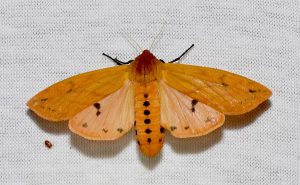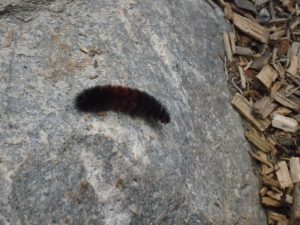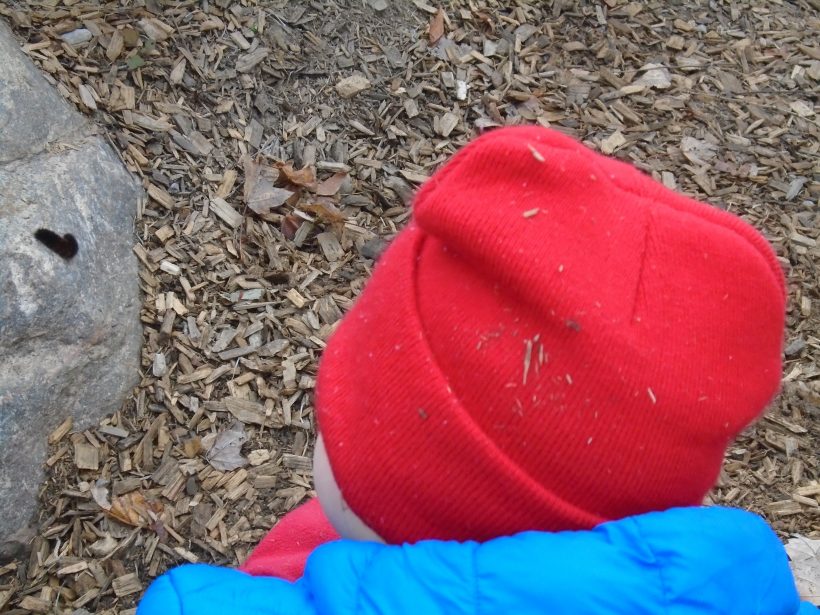WOOLLY BEAR WEATHER –November 2, 2023-11-02
No doubt you have encountered a woolly bear if you have spent any time out of doors of late. Woolly Bears, of course, are not really bears at all but the Isabella tiger moth in the making. There are approximately 260 species of tiger moth in North America and each species has slightly different colour patterns. This caterpillar is dark brown at both ends and golden in the middle. Reminds me of a belted Galloway cow which is white in the middle, book ended by dark ends – head and tail.

James Edward Smith named the woolly bear in 1797, according to Wikipedia. Folklore tells us that by studying the appearance of the woolly bear you can foretell what winter has in store for us. Those caterpillars with a wide golden band predict a mild winter. The more black the more severe the winter. In the fall of 2023 l saw some of each leaving me to wonder, which is correct?
Some History
During the fall of 1948 Dr. C.H. Curran, Curator of Insects at the American Museum of Natural History in New York City, took his wife to Bear Mountain State Park to look at woolly bears. Dr. Curran collected many woolly bears, determined the average number of reddish-brown segments and via a friend at The New York Herald Tribune forecast the coming winter weather. For the next 8 years Dr. Curran attempted to predict the anticipated winter weather. In time the woolly bear became as iconic as the monarch butterfly caterpillar and the tomato hornworm.
The WOOLly part of the bear is not wool-like at all but comprises short, stiff bristles of hair. Bye the bye, if you encounter an all-black woolly caterpillar, or an all-white one they are a different species and not used in folklore forecasting.
Curran’s study discovered that there was some merit to this forecasting folklore although there was little scientific merit to his study. Ultimately it became a fun-time excursion for friends to escape the city during the fall colours. They called themselves The Original Society of the Friends of the Woolly Bear. The Nature Museum at Bear Mountain State Park took up the banner some 30 years after the OSFWB stopped meeting and has carried on the tongue-in-cheek predictions since. Other places such as Banner Elk, North Carolina, Vermillion, Ohio and Lion’s Head, Ontario (began in 2011) host Woolly Bear Festivals in October which include winter weather forecasting.
University of Massachusetts entomologist Mike Peters says that “the number of brown hairs has to do with the age of the caterpillar…The band does say something about a heavy winter or an early spring. The only thing is … it’s telling about the previous year.”
There are two generations of woolly bear – the first appears in June/July, the second in September. These second generation bears are the weather prophets.
The woolly bear is most active during daylight seeking shelter under leaves, rocks, bark or fallen logs. After feeding on violets, lambs quarters, clover, plantain, dandelion and nettles they seek a ‘hide’ where they overwinter as larvae. They enter a ‘frozen’ state of hibernation until May when they emerge as the Isabella moth. The WB awakens on a warm spring day and continues to feed. Soon it forms a cocoon and pupates. In about two weeks an orange-yellow moth with a 1 ½ to 2 inch wingspan emerges. The wings lack distinctive markings but the abdomen is spotted with three longitudinal rows of small black dots. During the summer they are most active at night.
Sometimes it is referred to as the Hedgehog Caterpillar because of a tendency to curl up into a bristly ball and “play dead” when disturbed. The position of the longest dark bands apparently indicates which part of winter will be coldest, snowiest, hardest. If the head is dark the beginning of winter will be severe. If the tail end is dark the end of winter will be cold. The 13 segments of the body correspond to the 13 weeks of winter. Also, if the woolly bear is travelling south it’s trying to escape the cold. If it’s crawling north it predicts a mild winter.
The Truth is that the woolly bear’s colour reflects its feeding habits, age and species. The better the growing season the bigger the bear featuring narrower red-orange bands in the middle. The bear sheds six times before adulthood and each molt results in a colour change. They become less black and more reddish.
The bear’s fur is called setae and its function is to help the caterpillar freeze more controllably. They create a natural organic antifreeze called glycerol and they freeze ‘bit by bit’ until everything but the interior of their cells are frozen. The interior cells are protected by the hemolymph. They have survived -90 degree F temperatures. This can be seen in the Arctic where they live in a strange state of slow motion. For example, most caterpillars become moths after two to four weeks. In the Arctic it takes 14 years! The WB has even survived an entire winter completely frozen in an ice cube.

For fun, if the golden band is wide winter will be mild; the more black, the more severe the weather. As mentioned at the outset I have found both. They were all travelling south. Only next spring (2024) will I learn which was more accurate?
